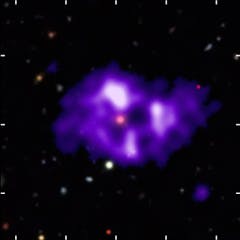
Articles on Radio astronomy
Displaying 1 - 20 of 106 articles

Astronomers caught the bizarre ‘awakening’ of an incredibly rare magnetic star.

An attempt to study gas in one galaxy with the MeerKAT radio telescope detected 49 other galaxies instead.

Projects under NASA’s CLPS program – including the Odysseus lander that made it to the lunar surface – will probe unexplored questions about the universe’s formation.

It’s too heavy to be a neutron star and too light to be a black hole. So what is it?

Do all big black holes in very massive galaxies emit radio waves? We used the latest radio telescopes to find out.

Previous searches for extraterrestrial life have included only the radio band above 600 MHz, leaving lower frequencies virtually unexplored.

A record-breaking discovery of an extreme ‘fast radio burst’ opens a window into the early universe.

Starlink satellites emit bright, unintended and unexpected signals that can be detected by radio telescopes.

New ASKAP images reveal a giant hydrogen ring around the spiral galaxy NGC 4632.

Astronomers have detected a long-running source of slow, repeating radio pulses that can’t be explained by current theories – but it’s probably not aliens.

Astronomers have detected the coldest star ever found to emit radio waves using the Australian SKA Pathfinder telescope.

Astronomers have for the first time detected the background hum of gravitational waves likely caused by merging black holes.

The darkness of the night sky seems so obvious as to need no explanation – yet it has intrigued and baffled scientists for centuries.

Our Sun will likely go out quietly – but not all such stars do. A new radio detection of a supernova can help us better understand these cosmic cataclysms.

The accumulated radio emission from mobile phones on Earth is beginning to become quite significant.

Magnetic fields billions of light years away offer clues to the nature of intense flashes from the sky known as fast radio bursts.

The current race to the Moon is opening up opportunities for lunar astronomy.

Machine learning is becoming an indispensable tool in astronomy by sorting through enormous datasets from telescopes.

Astronomers have long known where water is first formed in the universe and how it ends up on planets, asteroids and comets. A recent discovery has finally answered what happens in between.

Many telescopes use the radio spectrum to learn about the cosmos. Just as human development leads to more light pollution, increasing numbers of satellites are leading to more radio interference.

